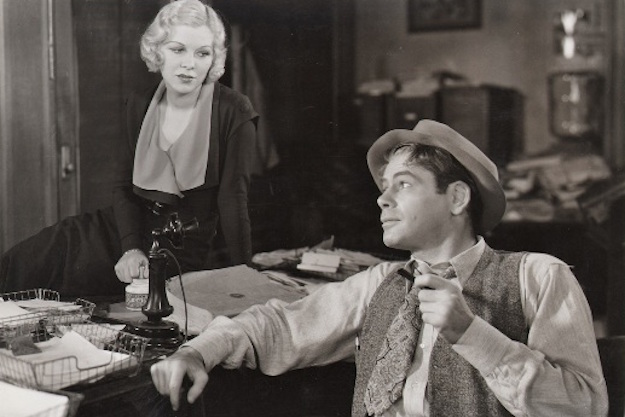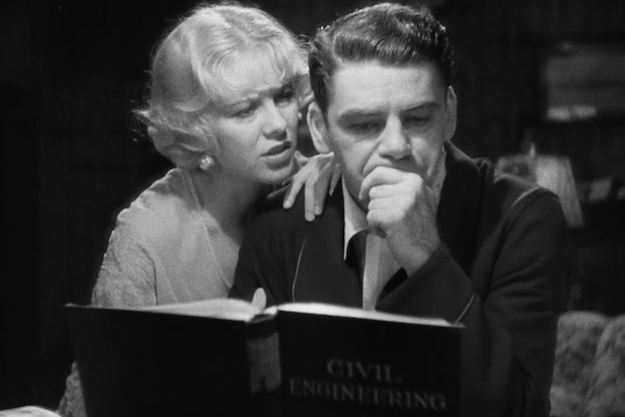Hi, Nellie! It will come as no surprise that the real Glenda Farrell wasn’t like the screen types she was known for—brassy gold-digging chorines, mouthy brothel proprietresses and, most famously, word-spitting, scoop-hoarding newspaperwomen like her Teresa “Torchy” Blane, the popular character who featured in nine Warner Bros. quickie B movies, seven of which starred Farrell. For one thing, no human ever truly resembled the exaggerated Torchy type; if you met someone who actually went around speaking 400 words in 40 seconds (as she does in 1938’s Torchy Gets Her Man), you would react with irritation or horror, and possibly recommend observatory medical quarantining. But Farrell, especially, conducted a different kind of life. A non-smoking, self-avowed “softie,” she told an interviewer: “I never wisecrack … and as for gold digging, I’ve never been able to wangle a thing—everything I’ve ever had, I’ve worked for and paid myself.” The Torchy Blane films are based on the “MacBride and Kennedy” stories by detective novelist Frederick Nebel, with the first screenplays credited to Kenneth Gamet and Don Ryan. And they derive from the fast-talking playbook developed by vaudeville comedians and for the stage by Hecht/MacArthur, among others. But Torchy herself—her gentle patience with the slower-witted, including the love interest detective played by Barton MacLane, the sly grin in the face of daunting odds, the way she insinuates her petite frame into rooms in which she isn’t allowed—is Farrell’s creation, the fruit of painstaking observations of female journalists (“girl reporters,” in the vernacular of the time), decades of acting experience and standout turns as reporters in previous pictures. The Oklahoma-born Farrell began her acting career at age seven in a Kansas production of Uncle Tom’s Cabin, and landed on Broadway in her early twenties, which is where an impressed Jack Warner caught her in a performance of Life Begins and offered her a contract that included a reprisal of her stage role in the 1932 film version. She had already featured prominently in the Warner Brothers gangster classic Little Caesar (1931), directed by Mervyn LeRoy. Her transition to movies would take her off the stage for about seven years, but it was where she learned her craft and the acting form she respected most, and she’d return to it for the remainder of her career following her flurry of film roles in the ’30s. Farrell developed her whipsmart, motor-mouthed persona from the jump, including in her numerous pairings with friend and fellow blonde Joan Blondell, but her first crack at the reporter type was in Mystery of the Wax Museum, one of a remarkable (and possibly unhealthy) 12-plus films in which she appeared in 1933. (“I went through the mill there . . . sometimes I would be in three pictures that were shooting at the same time,” she’s said of her WB years.) In 1932’s justly revered, ruthless I Am a Fugitive from a Chain Gang, Farrell is the carousing, venal boardinghouse proprietress who pettily threatens to blackmail made-good hero James (Paul Muni) back into chains when she learns he’s a wanted escapee. As James attempts to self-improve at night by reading civil engineering texts by considerate candlelight, Farrell’s pouty Marie moans that they never go out (they’d done so the previous night, James protests). Springing her trap, the cig-smoking vixen tells him, “You’re gonna be a bigshot someday with plenty of sugar, and I’m gonna ride right along, get that?” Fugitive was also directed by Warners stalwart LeRoy, who likewise directed Farrell in Three on a Match (1932), Heat Lightning (1934), and Hi, Nellie! (1934). Hi, Nellie! is of particular interest in its relative reputational neglect, its Muni-LeRoy-Farrell reteaming and the fact that Farrell’s Gerry Krale created the Torchy template, though Gerry is significantly meaner. As the film opens, she is stuck writing the popular “Heart Throbs” (per the frosted window decal) column under the alias Nellie Nelson, a position of mockery amongst the hard-bitten newsroom rats. City editor “Brad” Bradshaw (Muni), Gerry’s former flame, is one of the mockers, but when he buries a hot headline about a governor’s investigating-committee head who disappeared with a large sum of money, the publisher Graham (Berton Churchill) demotes Brad to lonelyhearts duty. Brad reacts by trashing his office and going on a dayslong bender—it’s Gerry who visits him at a bar to offer clarity, calling his bourbon of choice “rat poison,” a slight for which Brad later apologizes directly to the offended liquor. Brad’s half-sober solution is to write the column in earnest (an ink-blooded newsman, he is incapable of turning in lousy copy), which increases its popularity and dooms him to a permanent position, until more dirt in the disappearance mystery yanks him back into proper reporting.
I Am a Fugitive from a Chain Gang Hi, Nellie! shuffles genres (comedy, crime, romance, whodunit) as promiscuously as Graham does his employees’ desks, but it is rarely jarring, thanks to LeRoy’s competent direction and the uniform excellence of the performers from the Warners stable. LeRoy evokes the anxious buzz of the Daily Dispatch newsroom with judicious bits of style, like the tracking shot that follows Gerry as she negotiates another overture from a persistent office hack, and later the scenes at a nightclub with a merry-go-round in its middle, which allows for much perspective-shifting, graceful camera business. Besides Churchill, and familiar faces like Edward Ellis, there’s the cynical Ned Sparks as tipster Shammy, and the painfully well-named Donald Meek as an aged copy “boy” with hearing loss. Muni, his character’s hair streaked with gray from job stress, is having visible fun playing against type, so much so that his loud, mincing theatricality can be overbearing, but it’s Farrell who is the brightest light. Like Torchy, Gerry is the smartest person in the room, but that’s not the source of comic absurdity here—it’s merely the fact of the matter. Farrell would continue to act through 1970, earning awards for her television work and appearing in a diverse run of films including Talk of the Town (1942) and The Disorderly Orderly (1964), but it is with her wildly prolific run in the ’30s that she hatched her own type, the “made-tough, uncompromising, knowing, wise-cracking, undefeatable blonde,” in the words of friend and collaborator Garson Kanin. The field of artists who can take credit for creating not just a memorable character, but the kind of lasting archetype honed in Hi, Nellie! and crystallized in the Torchy Blane films is uncrowded, indeed. Glenda Farrell, November’s “Star of the Month” on Turner Classic Movies, stars in Heat Lightning (airing November 5), as well as I Am a Fugitive from a Chain Gang (November 5), Mystery of the Wax Museum (November 5), Life Begins (November 12), Hi, Nellie! (November 12), Torchy Gets Her Man (November 12), and Three on a Match (November 19). Justin Stewart is a writer whose work has appeared in Brooklyn magazine, Reverse Shot, and elsewhere.

